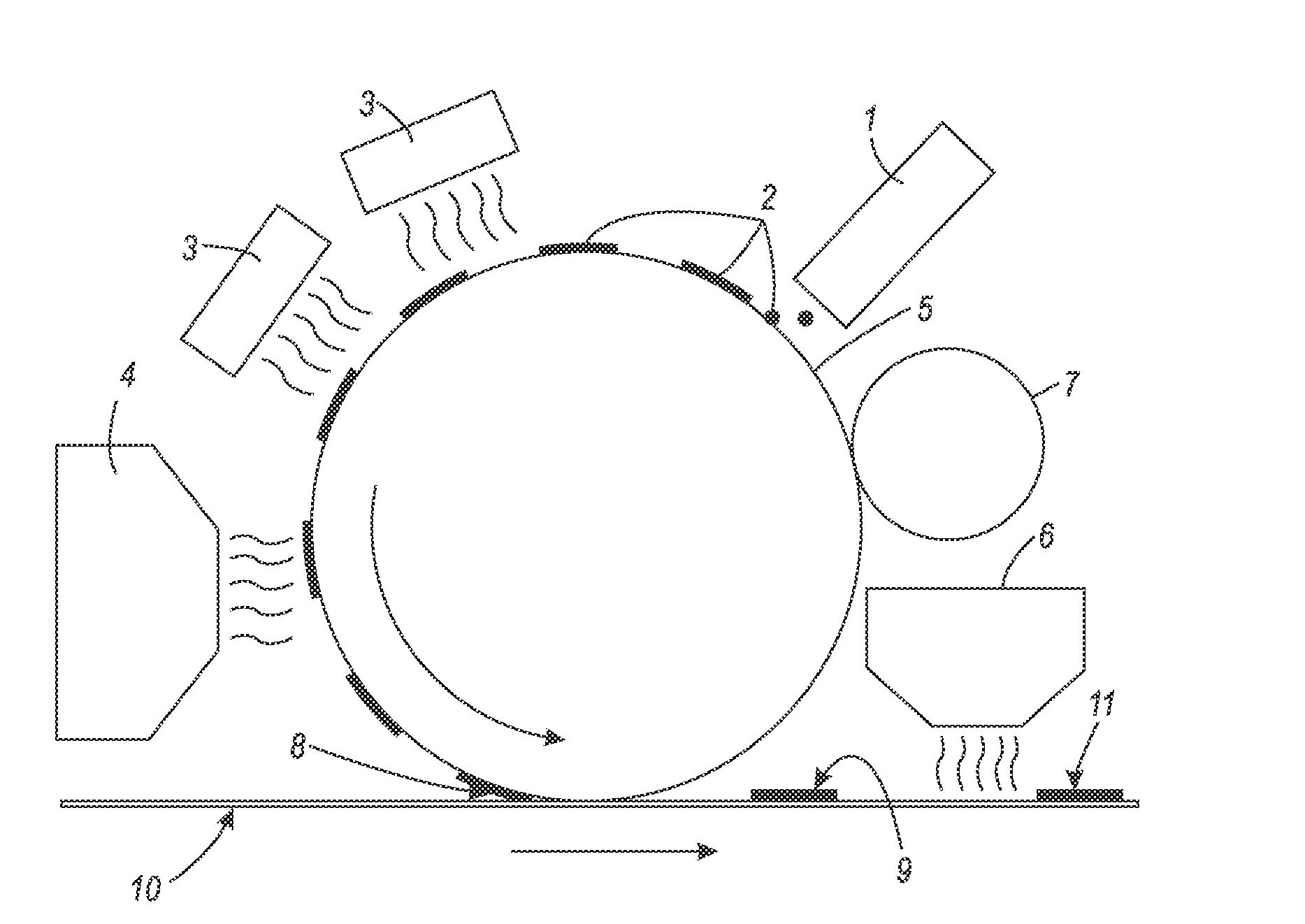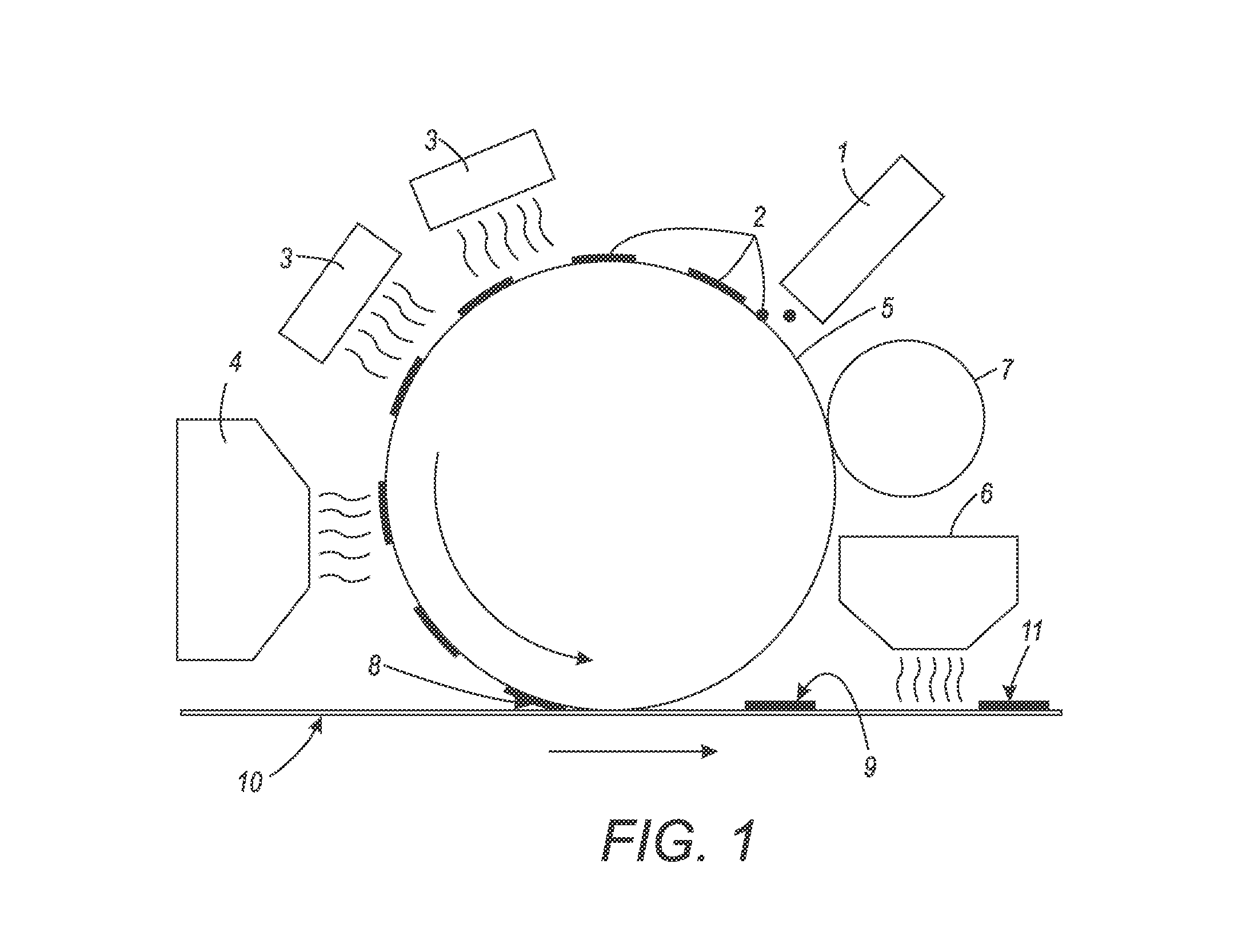Inkjet ink containing polystyren copolymer latex suitable for indirect printing
a polystyrene copolymer latex and inkjet technology, applied in the direction of printing, inks, other printing apparatus, etc., can solve the problem that there is no known commercially available ink that enables both wetting and transfer functions
- Summary
- Abstract
- Description
- Claims
- Application Information
AI Technical Summary
Benefits of technology
Problems solved by technology
Method used
Image
Examples
example 1
Preparation of Latex A
[0062]A latex emulsion (Latex A) comprised of polymer particles generated from the emulsion polymerization of styrene, n-butyl acrylate and β-CEA (2-carboxyethyl acrylate) was prepared as follows. A surfactant solution of 605 grams Dowfax 2A1 (anionic emulsifier) and 387 kg de-ionized water was prepared by mixing for 10 minutes in a stainless steel holding tank. The holding tank was then purged with nitrogen for 5 minutes before transferring into the reactor. The reactor was then continuously purged with nitrogen while being stirred at 100 RPM. The reactor was then heated up to 80° C. at a controlled rate, and held there. Separately 6.1 kg of ammonium persulfate initiator was dissolved in 30.2 kg of de-ionized water.
[0063]Separately the monomer emulsion was prepared in the following manner. 323 kg of styrene, 83 kg of butyl acrylate and 12.21 kg of β-CEA, 2.85 kg of 1-dodecanethiol, 1.42 kg of decane-1,10-diacrylate (ADOD), 8.04 kg of Dowfax 2A1 (anionic surfac...
example 2
Ink Formulation A
[0064]To a 50 mL amber glass vial was added surfactant and carbon black dispersion, while the mixture was stirred with a magnetic stir bar at 200 RPM, water (−20% to wash latex beaker) was slowly added. The pH of the latex was separately adjusted to 6.8 and then slowly added to vial which was chased with 20% water to clean latex's residuals. The ink was then homogenized for 5 minutes at 2000 RPM. Table 1 below shows the components of Ink Formulation A.
TABLE 1SolidsActualWeightSolid (ofmassInk APercent instockinComponentFunctionINKsolution)gramsLatex A10.00% 41.06%12.177Sulfolaneco-solvent15.84% 95.00%8.3372-pyrrolidinoneco-solvent3.33%100.00%1.665Poly(ethylene glycol)Viscosity0.72%100.00%0.360(Mw 20K)modifierCarbon Black 300pigment3.30% 14.87%11.096Dowicil 75preservative0.10% 100%0.050FS8050Surfactant0.161% 100%0.081Water52.03%100.00%16.234TOTAL50.000
example 3
Ink Characteristics
[0065]Rheology: Flow Sweep was performed using an Ares G2 controlled strain rheometer from TA Instruments equipped with a 50 mm parallel plate geometry. The resulting Ink A displayed favorable rheology, having viscosities below 10 cps at jetting temperature (e.g., measured as 5 cps at 32° C.).
[0066]Particle size: The pigment particle size was measured to be below 150 nm (or from 100 nm to 300 nm) using a dynamic light scattering technique such as with a Malvern Zetasizer particle size analyzer.
[0067]Surface tension: A sample of Ink A was measured on a K-100 Surface Tensiometer available from Kruss, equipped with a Wilhelmy plate at room temperature, about 27° C. Surface tension data was determined to be an average of 20 data points taken from 1 s to 60 s (e.g., measured at 21.7 mN / m).
PUM
| Property | Measurement | Unit |
|---|---|---|
| viscosity | aaaaa | aaaaa |
| surface tension | aaaaa | aaaaa |
| glass transition temperature | aaaaa | aaaaa |
Abstract
Description
Claims
Application Information
 Login to View More
Login to View More - R&D
- Intellectual Property
- Life Sciences
- Materials
- Tech Scout
- Unparalleled Data Quality
- Higher Quality Content
- 60% Fewer Hallucinations
Browse by: Latest US Patents, China's latest patents, Technical Efficacy Thesaurus, Application Domain, Technology Topic, Popular Technical Reports.
© 2025 PatSnap. All rights reserved.Legal|Privacy policy|Modern Slavery Act Transparency Statement|Sitemap|About US| Contact US: help@patsnap.com


